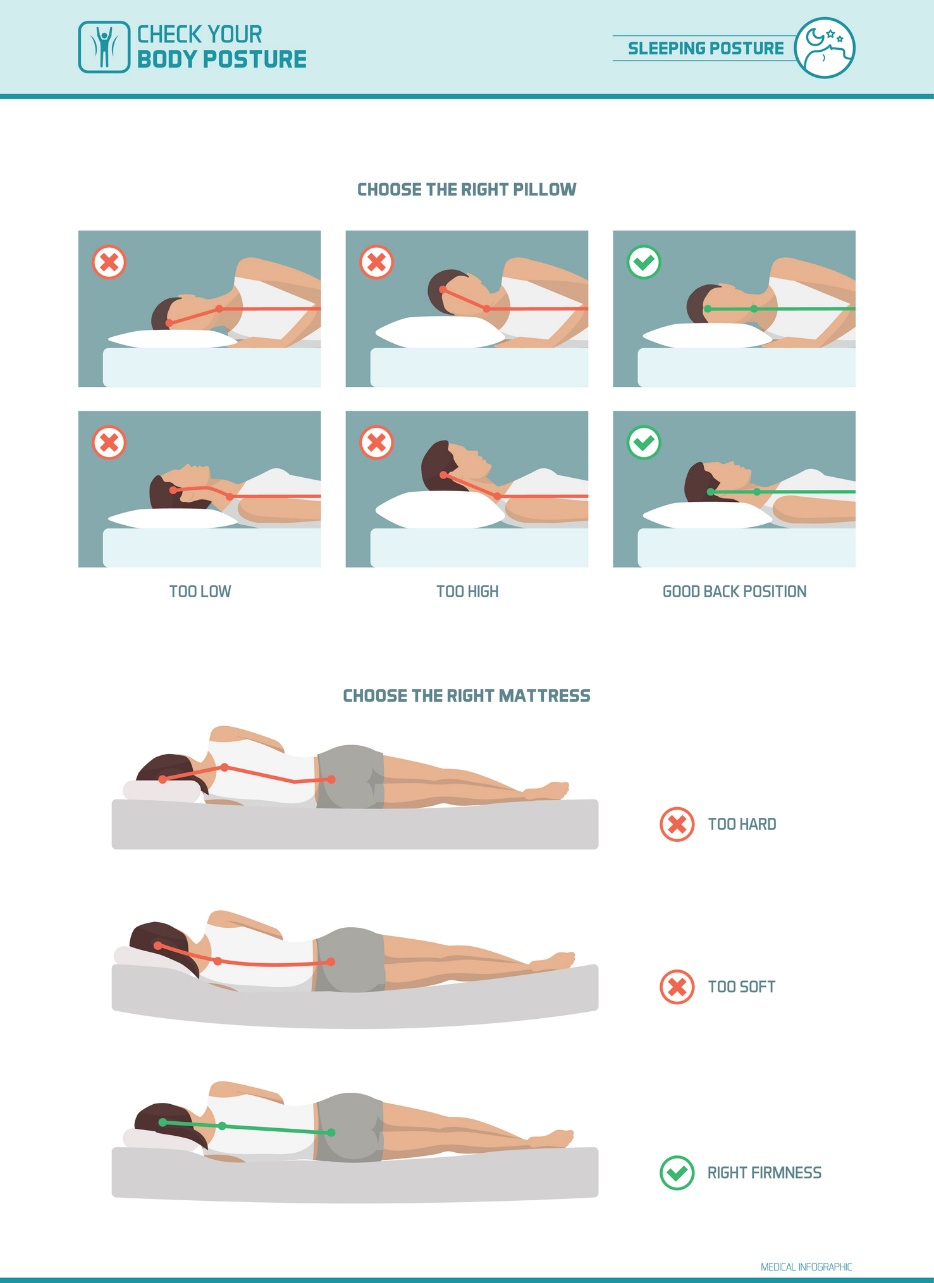- KOLÁŘ, Pavel. Rehabilitation in clinical practice. Second edition. Prague: Galén, [2020]. ISBN 978-80-7492-500-9
- LEDERLE, Katharina. Sleep to health: improve your sleep, improve your health. Translated by Martina BENEŠOVÁ. Olomouc: ANAG, [2021]. ISBN 978-80-7554-327-1
- verywellhealth.com - The Best and Worst Sleep Positions for Health Conditions. VerywellHealth. Brandon Peters, MD
- healthline.com - Best Sleeping Positions for a Good Night's Sleep. Healthline. Jandra Sutton
What are the right positions for healthy sleep? Choosing a pillow and mattress

Sleep position has an impact on a person's health, especially on the musculoskeletal system. In addition to proper sleep hygiene and sleep position, the choice of mattress and pillow is also important for a good night's sleep.
Article content
The correct sleep position can have a positive effect on our health. It is worth spending some time thinking about sleep hygiene and the health benefits of sleep position itself.
What are the advantages and disadvantages of sleeping on your back, stomach and side? How to choose the right mattress or pillow and lots of other information can be found in the following article.
Position, sleep and health
Sleep is an integral part of life. On average, a person sleeps 1/3 of the day. Sleep serves to regenerate the body, recharge energy, ensure proper functioning of the musculoskeletal, cardiovascular and nervous systems, regulate metabolism and many other internal processes.
Quality sleep is the basis for the proper functioning of the human organism throughout the day.
Sleep significantly affects a person's physical and mental health. The length of sleep is individual with respect to age, health, physical and mental activity during the day. However, an adult should sleep at least 7 hours a day and night.
The correct sleeping position is individual and depends mainly on the health of the individual. In case of health complications, surgery, pregnancy and any uncertainty about the suitability of the position, consultation with a doctor is necessary.
Sleep position affects the stability and mobility of the spine, breathing, digestion, cardiovascular function and the functioning and recovery of the muscular system.
In the same way that it is essential to ensure correct posture and positioning during daily physical activity or when working and sitting, appropriate positioning and environment can eliminate the occurrence of musculoskeletal disorders at night.
We often change our sleeping position uncontrollably. It is therefore advisable to think about the ideal sleeping position and the ideal mattress or pillow to use.
We recognize a large number of sleeping positions, but primarily divide them into 3 basic ones:
- Supine position
- Side sleeping position
- Supine position
Supine position
Lying on the back, with certain principles, is considered particularly good for back health. This position ensures an even posture of the head and cervical spine. The spine in this position occupies a physiological position, thus preventing back and neck pain.
However, despite the benefits, this position is considered less comfortable.
Placing a small pillow under the knees can provide appropriate support and help create physiological curvature and relief for the spine. It is not recommended to place excessively large pillows under the head as this may result in back, head or neck pain.
The supine position with a pillow is beneficial for those with digestive problems and heartburn. The digestive system descends from the mouth opening to the stomach, creating a slope that prevents stomach acid problems.
The position on the left side is also good for digestion.
Sleeping on the back is also a good position for relaxing the skin and less chance of wrinkles. Women's breasts also have natural support without increased pressure.
The disadvantage of the supine position is the risk of a tendency to snore or to stop breathing during sleep. If snoring does occur, it is more intense. It is therefore not entirely suitable for people with breathing problems and especially with snoring.
Sleep apnoea is a more serious condition. In it, the throat closes during sleep, leading to intermittent pauses in breathing.
Position on the stomach
Sleeping in the prone position is beneficial for a young child due to the activation of certain anatomical pressure points that stimulate the child's proper development and neural activity.
In adulthood, sleeping on the stomach has advantages, it is considered comfortable. However, the disadvantages prevail.
The natural curvature of the spine is not fully supported in the supine position, which can subsequently cause pain. This is particularly true of the cervical region, which can be rotated to one side throughout sleep. There is also increased pressure on the joints of various muscle groups.
If you like to sleep on your stomach, you should not have a pillow that is too big and thick under your head. A thin pillow that does not elevate your head and neck is ideal.
When lying on your stomach, it is a good idea to lighten your spine by bending your leg at the knee and pulling it slightly towards your body.
In the case of cervical spine pain, it is advisable to place a pillow under the abdomen and hips on the side where the knee is raised. This will reduce the load on the cervical spine.
The disadvantage of this position is that the face is buried in the pillow. This can promote the formation of wrinkles. The position on the stomach is also a possible disadvantage for digestive problems and heartburn.
The advantage of sleeping on your stomach is the prevention of snoring and symptoms of sleep apnea. The upper airway is more open in this position.
Some people find this position beneficial for lumbar spine pain because it balances the pressure in the intervertebral discs of the spine.
Lateral position
The side position is a popular and common sleeping position. It is based on the development in the womb, which is a natural position for us. When certain principles are followed, it is good for the health and curves of the spine.
Compared to the supine position, it also reduces the risk of snoring.
A suitable position when sleeping on your side is a slight bending of the knees towards the chest, which reduces the pressure on the spine.
For back pain in particular, it is advisable to place a pillow between the knees (lower legs) to reduce pressure on the hip joints and lumbar spine.
When sleeping on your side, be careful of the shoulder joints, which can interfere with blood circulation and restrict the proper function of nerves or muscles if pressure is constantly applied. It is therefore advisable to push the shoulders forward. This will prevent the shoulder muscles from being compressed.
It is recommended to sleep especially on the left side as this can relieve indigestion, promote digestive function and eliminate heartburn.
Some articles point to a possible increased risk of wrinkles due to immersing half of the face in the pillow.
Sleeping on your side in pregnancy
Sleeping on the side is considered the most suitable position for sleeping even during pregnancy. Some research points to the suitability of sleeping on the left side, which positively affects blood flow to the fetus.
Sleeping on the back and on the stomach, on the other hand, is not recommended. To eliminate pain and improve the quality of sleep, it is a good idea to use a special pregnancy pillow. This relieves the pressure on the spine and also serves as a support for the woman's growing abdomen.
Choosing the right mattress
An important part of a good quality sleep with sleep hygiene is choosing the right mattress.
A mattress that is too soft is not suitable because it does not provide enough support for the body and the body sinks into the mattress. The spine may be curved and unphysiologically arched.
Conversely, a mattress that is too hard can be uncomfortable and cause excessive pressure on the shoulders, hips, and spine.
A suitable choice is an individually selected medium to firmer mattress. The specific choice depends on the feel, comfort and weight of the individual. The higher the person's weight, the firmer the mattress is better.
A good quality and well chosen mattress can bring pain relief and improve the quality of the sleep itself. It is advisable to choose a mattress with better quality materials that adapt to the anatomy and movement of the body during sleep.
It is advisable to choose a mattress in person, with the opportunity to lie on it and try it out. On the other hand, it is not advisable to choose a mattress via the internet or other people's recommendations.
The main criterion when choosing a mattress should be quality, not price.
The price of a mattress increases in direct proportion to its quality. When choosing a mattress made of highly resilient memory foam, you should expect to pay more.
A quality mattress will last in excellent condition for several years with proper care.
Choosing the right pillow
As unimportant as the choice of pillow may seem, the opposite is true. A quality pillow with the right thickness is important for proper positioning of the head and cervical spine during sleep. It prevents headaches and muscle imbalances in the cervical region.
Sleeping without a pillow is not suitable because the head droops and the spine is not in a physiological plane. Conversely, a pillow that is too large and thick causes a change in the position of the head and increases the risk of muscle imbalances in the neck.
If you underestimate the importance of a pillow for healthy sleep, you may wake up in the morning with a stiff neck or headache.
A pillow that is comfortable to the touch and whose thickness creates a physiological line between the spine and the head is suitable. The pillow should not extend below the shoulders; the arms should already be buried in the mattress itself.
For people prone to neck pain, an anatomical pillow is particularly recommended. Its special shaping helps to improve sleep, comfort the cervical spine and eliminate snoring.
The choice of bed linen, blankets or quilts that come into direct contact with the skin is also important for a good night's sleep. Bed linen should be pleasant to the touch, made of non-irritating, non-artificial material, cleaned and changed regularly.
Items with potential allergens (dust, dust mites, feathers, flowers, etc.) should also be kept out of the bedroom.

Interesting resources
Related










